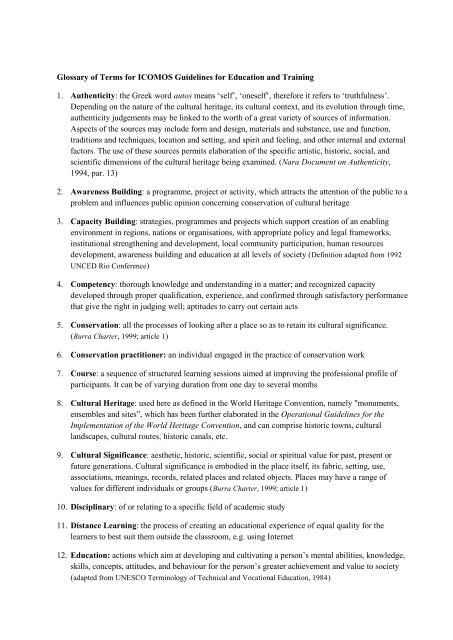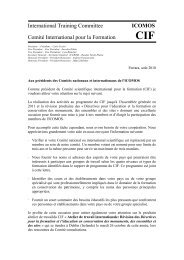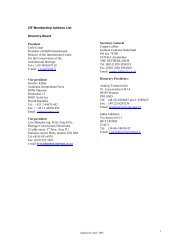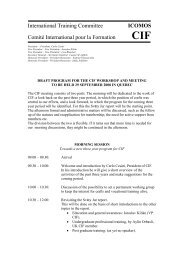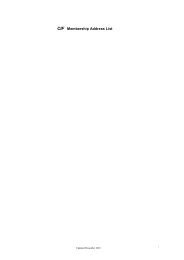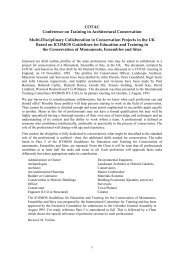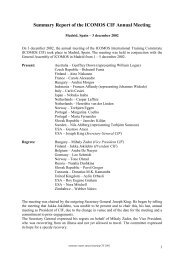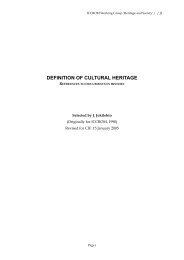Glossary of Terms_CIF Guidelines.pdf - Icomos
Glossary of Terms_CIF Guidelines.pdf - Icomos
Glossary of Terms_CIF Guidelines.pdf - Icomos
You also want an ePaper? Increase the reach of your titles
YUMPU automatically turns print PDFs into web optimized ePapers that Google loves.
<strong>Glossary</strong> <strong>of</strong> <strong>Terms</strong> for ICOMOS <strong>Guidelines</strong> for Education and Training<br />
1. Authenticity: the Greek word autos means ‘self’, ‘oneself’, therefore it refers to ‘truthfulness’.<br />
Depending on the nature <strong>of</strong> the cultural heritage, its cultural context, and its evolution through time,<br />
authenticity judgements may be linked to the worth <strong>of</strong> a great variety <strong>of</strong> sources <strong>of</strong> information.<br />
Aspects <strong>of</strong> the sources may include form and design, materials and substance, use and function,<br />
traditions and techniques, location and setting, and spirit and feeling, and other internal and external<br />
factors. The use <strong>of</strong> these sources permits elaboration <strong>of</strong> the specific artistic, historic, social, and<br />
scientific dimensions <strong>of</strong> the cultural heritage being examined. (Nara Document on Authenticity,<br />
1994, par. 13)<br />
2. Awareness Building: a programme, project or activity, which attracts the attention <strong>of</strong> the public to a<br />
problem and influences public opinion concerning conservation <strong>of</strong> cultural heritage<br />
3. Capacity Building: strategies, programmes and projects which support creation <strong>of</strong> an enabling<br />
environment in regions, nations or organisations, with appropriate policy and legal frameworks,<br />
institutional strengthening and development, local community participation, human resources<br />
development, awareness building and education at all levels <strong>of</strong> society (Definition adapted from 1992<br />
UNCED Rio Conference)<br />
4. Competency: thorough knowledge and understanding in a matter; and recognized capacity<br />
developed through proper qualification, experience, and confirmed through satisfactory performance<br />
that give the right in judging well; aptitudes to carry out certain acts<br />
5. Conservation: all the processes <strong>of</strong> looking after a place so as to retain its cultural significance.<br />
(Burra Charter, 1999; article 1)<br />
6. Conservation practitioner: an individual engaged in the practice <strong>of</strong> conservation work<br />
7. Course: a sequence <strong>of</strong> structured learning sessions aimed at improving the pr<strong>of</strong>essional pr<strong>of</strong>ile <strong>of</strong><br />
participants. It can be <strong>of</strong> varying duration from one day to several months<br />
8. Cultural Heritage: used here as defined in the World Heritage Convention, namely "monuments,<br />
ensembles and sites”, which has been further elaborated in the Operational <strong>Guidelines</strong> for the<br />
Implementation <strong>of</strong> the World Heritage Convention, and can comprise historic towns, cultural<br />
landscapes, cultural routes, historic canals, etc.<br />
9. Cultural Significance: aesthetic, historic, scientific, social or spiritual value for past, present or<br />
future generations. Cultural significance is embodied in the place itself, its fabric, setting, use,<br />
associations, meanings, records, related places and related objects. Places may have a range <strong>of</strong><br />
values for different individuals or groups (Burra Charter, 1999; article 1)<br />
10. Disciplinary: <strong>of</strong> or relating to a specific field <strong>of</strong> academic study<br />
11. Distance Learning: the process <strong>of</strong> creating an educational experience <strong>of</strong> equal quality for the<br />
learners to best suit them outside the classroom, e.g. using Internet<br />
12. Education: actions which aim at developing and cultivating a person’s mental abilities, knowledge,<br />
skills, concepts, attitudes, and behaviour for the person’s greater achievement and value to society<br />
(adapted from UNESCO Terminology <strong>of</strong> Technical and Vocational Education, 1984)
13. Evaluation: a systematic and objective process to determine the relevance, effectiveness or impact<br />
<strong>of</strong> activities in the light <strong>of</strong> the specified objectives (adapted from UN Task Force on Rural Development,<br />
Monitoring and Evaluation Guiding Principles, 1985)<br />
14. Heritage Conservation Expert: heritage conservation practitioner with recognised experience<br />
15. Heritage Conservation Specialist: heritage conservation practitioner with recognised qualifications<br />
acquired through specialised education and training<br />
16. Intangible Cultural Heritage: the practices, representations, expressions, knowledge, skills – as<br />
well as the instruments, objects, artefacts and cultural spaces associated therewith – that<br />
communities, groups and, in some cases, individuals recognize as part <strong>of</strong> their cultural heritage<br />
(Convention for the Safeguarding <strong>of</strong> the Intangible Cultural Heritage, Art. 1)<br />
17. Integrity: a measure <strong>of</strong> the wholeness and intactness <strong>of</strong> the natural and/or cultural heritage and its<br />
attributes (WH Op. <strong>Guidelines</strong>, 2008:88)<br />
18. Pr<strong>of</strong>essional: an individual who has achieved recognised level <strong>of</strong> pr<strong>of</strong>iciency in a trade, or who has<br />
been formally certified by a pr<strong>of</strong>essional body to a specific pr<strong>of</strong>ession by virtue <strong>of</strong> having completed<br />
a required course <strong>of</strong> studies and/or practice . And whose competency can usually be measured<br />
against an established set <strong>of</strong> standardised criteria<br />
19. Protection: understood in legal terms as the action required to provide the conditions for a<br />
monument, ensemble or site to survive; the term is also related to the physical protection <strong>of</strong> the same<br />
20. Cultural Resource: a human work or a place that gives evidence <strong>of</strong> human activity, has spiritual or<br />
cultural meaning, and/or has importance or influence on human history<br />
21. Standards: prescribed procedures or qualities <strong>of</strong> products, materials, techniques and technologies<br />
22. Sustainable management: takes the concepts from sustainability and synthesizes them with the<br />
concepts <strong>of</strong> management. Sustainability has three branches: the environment, the needs <strong>of</strong> present<br />
and future generations, and the economy. Using these branches, it creates the ability to keep a system<br />
running indefinitely without depleting resources, maintaining economic viability, and also<br />
nourishing the needs <strong>of</strong> the present and future generations<br />
23. Teaching:<br />
24. Training: activities directed at providing specialised skills, knowledge and attitudes required for<br />
employment in the conservation field (adapted from UNESCO Terminology <strong>of</strong> Technical and Vocational<br />
Education, 1984)


